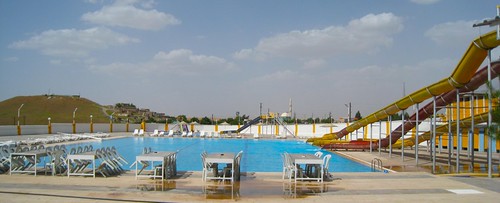Friday, August 13, 2010
Graduation Day!
Tuesday, July 27, 2010
Excuses, excuses.
In short, it feels a little like this:

Sigh.
Friday, July 23, 2010
WTF Iraq: Pizza chef with a license to kill

"This pizza chef has a license to kill."
This Pudgy pizza chef is debonair, clever and heartlessly cruel in a kinda sexy way. While that may make for a dashing date, I won't be trying whatever he's dishing out any time soon.
Thursday, July 22, 2010
Blind and love to read? No problem here.
Last week, Dilpak brought in a couple of copies and I'm kind of obsessed with them. Here's what they look like.
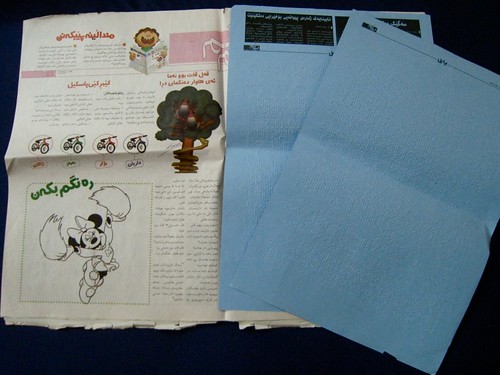
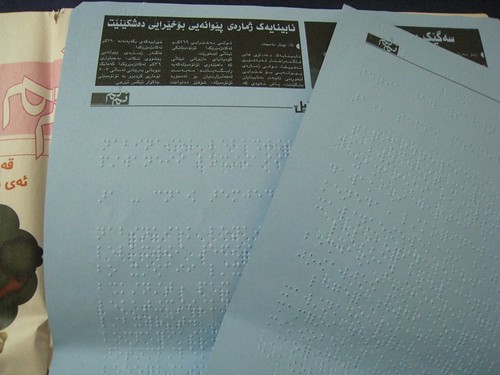
These also make me wonder how non-western languages are translated into braille. As I understand it, Braille isn't phonetic. It directly converts letters from a given language into a series of dots. So who decides how to convert non-standardized languages like Kurdish into braille and what dialect do they use? I did a little Googling and didn't find a real answer. In fact, I found remarkably little information on how Braille alphabets are formed across languages. If you have any ideas or expertise on the subject, I'd love to hear it.
Wednesday, July 21, 2010
Visa: The final installment
Final visit to the visa office: 1.5 hrs, Four three-month visas APPROVED!
After waiting an hour in the reception of the director’s office in the hopes that he would sign some magic paper to help us along, we shuffled into the hallways dripping with sweat and hating our lives. We got a magic paper but it was still at least 100 degrees inside the building and we had four or five more offices to go to.
Just as we thought we were going to melt into the floor before our visas would ever be approved, one of our students appeared out of nowhere. As it turns out, he spends a lot of time in the immigration office helping foreign students get their visas. He took our paperwork and dashed away. We ran to keep up with him as he hurried from office to office, repeating, “just one moment! Just one moment!”
A half hour later, he handed us our stamped visas with a sly smile. Visas for everyone!

Tuesday, July 20, 2010
A day in the country
It’s so dry and hot here that any patch of grass or open land is fair game for a little mini retreat for a couple or family – I’ve seen them camped out on the grassy medians in the middle of wide boulevards, on flowery parking lot dividers at the mall, and on hillsides off busy streets.
So I was pretty excited when my student, Sahar, invited me on a field trip with her sister out to Shaqlawa, a town about an hour and a half away that is a popular vacation spot, especially for Southern Iraqis.
We checked out the other picnic spots on the way, where people park their cars after nightfall and small bonfires burn deep into the evening.
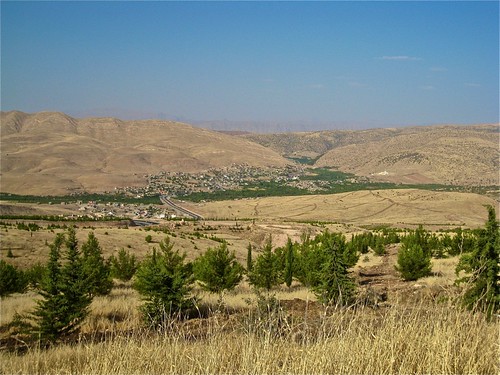


Then we entered Shaqlawa, a cozy little town that seemed a world away from the heat and dryness of Erbil. The mountains make the region noticeably cooler than Erbil and the deep red dirt is often spotted with tiny white flowers. It’s a world of soft rolling hills, trees (it’s been so long since I’ve seen lots of trees!) and a main street with dozens of candy shops, spice and fabric shops with their wares draped over the doorways and tumbling into the streets.
We planned to return after nightfall, when Sahar promised me the town would be bumping. We headed out to a graveyard and ancient church where Sahar swore she had heard voices screaming at night that stood at the front of a natural cave. We climbed up the hillside to the mouth of the cave, where people light red candles and wedge them into the rock face in the hopes that their wishes would come true.


Unfortunately we learned that the candles were available back down at the bottom of the hill so we saved our wishes for next time and headed down again for our picnic.
Finally we headed back in to Shaqlawa, and Sahar was right, the sleepy town’s main street was packed with people, sitting at neon-drenched restaurants, bouncing in huge trampoline beds, shopping for hats and trinkets and dancing in the streets with each other. Even at 11 at night, the streets were full, mostly of tourists who had come up from Baghdad and surrounding areas to escape the heat and intensity of the city.
Friday, July 9, 2010
Security situation in Erbil
Sidenote: Larry King tried to question Israeli PM Bibi Netanyahu about this video, shot in the West Bank. As The Daily Wh.at reports, the conversation was an epic fail for both men.
Thursday, July 8, 2010
Turkish Embassy FAIL
After a 3-hour trip to the border, Grant was denied entrance into Turkey. He had flown into Erbil from Jordan so there was no Turkish visa stamp in his passport. Apparently you can leave Turkey from the border but can't get back in unless you're making it a round trip.
This seemed pretty arbitrary to us, so Jon tried to call the Turkish embassy in Erbil to have them help us sort this out.
When he called the number on the embassy website, the receptionist was very friendly and listened to the whole situation. Then he said, "I'm sorry sir, we don't have a reservation for a Mr. Slater."
"What?" Jon didn't understand. "Who am I talking to?"
"This is the Erbil International Hotel, sir."
That's right, the Turkish embassy's official point of contact in the capital city of Northern Iraq is the impostor Sheraton hotel beloved by over-moneyed expats the region over.
Grant eventually crossed the border and got to Diyarbakir safe and sound, but we never found the number for the real Turkish Embassy. In short, #TurkishsolutionFAIL.
Tuesday, July 6, 2010
WTF Iraq: Shrink-wrap Taksi!
Luckily, I finally took enough pictures to show you some cab awesomeness.
Here's what you need to know about Erbil's taxis (or Taksi, as most of their roof lights endearingly announce.) Almost every car has a broken windshield. I've asked a lot of people why their windshields are broken and gotten a wide range of answers, but most of it seems to boil down to heat, dust storms and rocks falling off of all the construction trucks prowling the city.
Next, you need to know that although their windshields are janky, every cab driver seems to have an insane resistance to using their cars. Or rather, to allow their cars to look used. In most cases, they never remove the factory shrink-wrap on any part of the car. I've seen 3 and 4-year-old cars with shrink wrap still on the hoods.
Normal wear and tear on upholstery, knobs and anything else you can touch inside a car is not acceptable for these guys. Instead, taxi drivers cover everything with plastic, tape, shrink-wrap and bubble wrap. Then they add as many stickers as possible to make the cars look new. Anything that says 2010 is great. Even if it's for a random appliance or grocery item, not the car they're driving. Grease pen on the windshield? Great. Looks like they just drove off the lot. Better yet - 2010 emblazoned on the outside of the windshield with a crack 'n peel. Blinker signals and windshield wipers are bubble-wrapped for their own safety. And since it never rains here, there's no reason to take the TOYOTA plastic wrappers off the windshield wipers.
But really, why am I telling you all this? Pictures are so much better. Enjoy.
Monday, July 5, 2010
Happy Fourth of July!
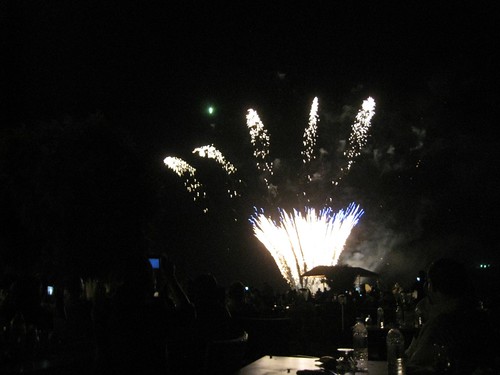
Yesterday our motley group of American housemates celebrated our nation's independence at a fancy hotel somewhere in the outskirts of Erbil, Iraq.
We'd been looking forward to the party for weeks, or at least I had. The flyer our housemate Darshak showed me had a picture of a big straw hat like the kind they wear in New Hampshire parades, details written in red, white and blue, fireworks promised and most importantly, the words "AMERICAN BARBECUE!"
Even though I knew I wouldn't even smell a pork rib within 50 miles of the event, I kept my hopes high.
We piled into a taxi and headed out toward the hotel, which was way, way outside of town. Security was tight and once we got to the hotel on top of a huge hill in the middle of nowhere we realized that the barren hillside was in fact peppered with personal security dudes, armored land cruisers and the occasional serious looking man in fatigues. The army guys looked at us a little funny when the five of us spilled out of the cab in front of the lobby.
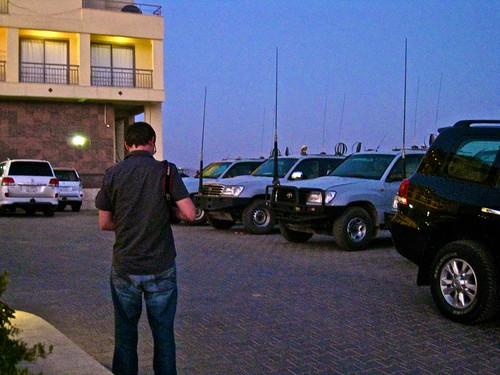 [Jon taking a snap of those armored cars in front of the lobby]
[Jon taking a snap of those armored cars in front of the lobby]The party was, like any Fourth of July celebration, in the backyard. I'm not sure where they found this, but Friends of Kurdistan had a 5-story-tall flag strung up from the hotel's roof.
There were hundreds of American contractors, dignitaries and families milling about and I can assure you that the small talk was just as awkward as it is back in the States. But some things just weren't the same. There was an egg toss and tug-o-war, which was great:
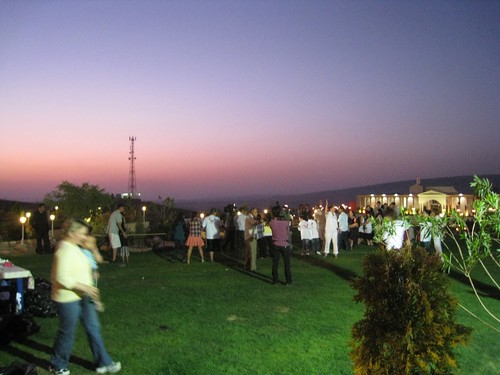
But somehow there was still too much absent from this party. Like music, or loud rowdy people drinking copiously (though somehow I have a feeling that had to do a lot more with the overpriced cash bar).
But worst of all? NO BARBECUE. Not a single marinated hock of beef. Nothing that even resembled American barbecue. There were lamb hamburgers, but no cheese. There were hot dogs, but no ketchup or mustard. And there were absolutely no hamburger or hotdog buns of any kind.
God bless America and their six-packs of fluffy hot dog buns.
So I'll admit that the whole thing was a little weird. They set off the fireworks a little early and I can safely say that in any country there are always a few random fireworks that go off at the end after the finale is over. Then afterward, everyone filed out and went home. It was a work night in Iraq.
I wish I had some great insight between Iraq and the United States, some great wisdom to share about spending our independence day in a place that we "set free," about what that means really. About the words America uses in places like Iraq, like freedom and democracy. What that means to us and to Iraq as nations. But no one got drunk enough to have that conversation at the party last night. Maybe we can start that discussion here. Anyone have that conversation at a rager last night? I'd love to hear what you were thinking as the fireworks blasted.
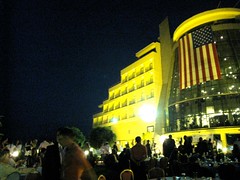
Sunday, June 27, 2010
I don't think that's sound construction...

Here's a half-finished, half-flooded townhouse just waiting for a good family to call it home.
**Correction: I was informed by one of my students that it is actually perfectly normal and common practice to flood wet concrete to make it stronger. So apologies to the family who will live in this very sturdy home one day! But it still is sort of a freaky weird picture so I'm leaving it up.**
With new buildings on the rise at a blazing rate in Erbil, it seems there's always some oddball thing or other to see in a semi-finished house. My favorite? Only three walls of a townhouse done with the kitchen tiles already in place.
I've yet to get a good photo of this kind of stuff, but one of the most disconcerting things to see - yet very commonplace in this area of the world- is the use of long sticks to prop up whole concrete building skeletons as they're being built. Picture a whole floor level, held in place by a couple of cinder-block columns and hundreds of sticks wedged between the floors at various angles like toothpicks... a method used even for high-rises. If that seems like an iffy practice, you're right. There's a giant commercial building just down the road from us that collapsed when it was only three-fourths done.
Electric wiring is also a major problem here. Electricians seem to favor haste over prudence, leaving exposed wires or giant bundles of cables on the outsides of buildings. One of the bar-owners in town just lost everything because his brand new house burst into flames after an electrical short.
And while this town isn't short on new housing, there seems to be no reliable home insurance in the region, leaving people like this guy up a creek if construction is faulty.
Hear that, my entrepreneurial insurance-minded friends? If you can figure out how to make it work over here, you could make a killing with the long-term expat crowd at least.
Monday, June 21, 2010
Plagiarism? Piracy? Not here.
It's all fun and games when you're driving by the Max Toast's golden arches or picking up a fresh copy of Sex & The City II from the bazaar.
But in my opinion, many people here have a totally different, and from my view, incomprehensible opinion on personal rights to one's own work and information.
Here's a quick story for you. Just a few days after arriving with Iraq, Jon and I had a meeting with the Hawler, a local paper here. The editor gave us a bunch of their weeklies to flip through as we were talking and as Jon started checking out the first of the stack, he stopped dead. "This is my picture!"
The editor leaned over to check out the page.
"I took this two years ago, in Erbil!" Jon was incredulous. The paper had been printed two weeks before.
The editor took the paper, looked at it and laughed. "We should have at least given you an attribution!"
 [Jon's snap of his snap published without permission, attribution, or compensation.]
[Jon's snap of his snap published without permission, attribution, or compensation.]Similarly, after publishing a recent blog on the Huffington Post, I got a message from a Kurdish journalist thanking me for writing the post and letting me know that he was going to translate it into Kurdish and publish it in his magazine. There was no question of permission or consultation, just a friendly FYI over Facebook that it would be printed for Kurdish readers in a local magazine. Blog posts are often reposted with attribution online -- they're the type of content that fall into the hazy milieu of things that should be spread quickly and easily, but written by people who are often working just as professionally as print journalists or photographers. It's not uncommon to have a blog republished on five or 15 other sites. So in this case I swallowed my usual objections and asked politely for a link to see where my work was being placed. I got the link to it today, which, considering it's for my article, I have no problem showing you guys here:
 [You can see a larger version by checking out Page 2 at this link: http://en.calameo.com/read/000206241ef82f5e7d7a6]
[You can see a larger version by checking out Page 2 at this link: http://en.calameo.com/read/000206241ef82f5e7d7a6]But as you can imagine, with two such recent run-ins with copyright infringement, I find it a little hard to swallow that cavalier attitude toward taking people's work, online or in print. Plagiarism is plagiarism, no matter what you're stealing or how you're using it, if you don't give the owner credit.
I'm having a hard time explaining the importance of this to our students. For our first assignment, we asked each of them to create an interactive timeline about their family history, to get the basics of telling stories in a visually engaging way. We asked them to collect stories from their families, as well as family photos and pictures of artifacts from their homes to help them tell their story.
Imagine my surprise when, as each student stood to present, they proudly showed us their family's stories accompanied with some of the most iconic photos from the last 20 years in the region. There wasn't any shame there -- many students had used the same photos as each other in their timelines. It wasn't like they were trying to hide the fact that the photos were stolen from the Internet. It was just that there was nothing wrong with it. We requested all the students remove photos that weren't theirs from their family histories.
During the second draft presentations, same thing. Internet photos abloom, all across the timelines. Again, we said, why would you want someone else's photos in your family history? Take them off.
So now I'm wondering how to make this lesson stick. It's hard in a place where journalism is undergoing a sort of Renaissance, where papers are plentiful and successful in their own ways, to explain that it's this sort of glib attitude toward the value of people's work, toward reusing it without proper attribution or compensation and in the process devaluing it, is a huge contributing factor to what's killing American newspapers.
I'll be the first to admit I am definitely a hypocrite in this - somehow it seems way worse to me to see a photographer or a journalist struggling to pay the bills have their work directly stolen, than to see a movie or brand be pirated. Having a face on that money lost, that career waylaid, makes it harder to be blase about piracy and plagiarism. It would be hard for me to see someone's picture on the back of a book jacket before I photocopied from the book's pages. 'Cause I'm right there with them.
I want to tell my students, take these people's work, and you're taking their living, and then no one can enjoy the fantastic pictures they shoot. But I'm not sure how to make that lesson sink in yet, and I'm a little afraid that when it does, it's because the journalism industry here will have been troubled by this attitude just as the American industry has, and that Iraqi journalists will be struggling to pay the bills because of it.
Saturday, June 19, 2010
Creator of U.S. Kurdish library dies, what a fantastic woman.
I called The Kurdish Library in New York to get some basic information for some research I was doing. When I asked if I could speak with the curator of their collections, she laughed and said "You got her." I soon found myself in an hour-long conversation with this remarkable woman: a razor sharp, twice married mother of five who changed how the Kurds' story has been recorded in history.
She told me how she, a young Jewish divorcee pursuing a degree at Columbia, had met her neighbor across the air-shaft after her apartment was robbed, and how they started having conversations by talking out the window to one another. How one day he brought her a cake and he was so dressed up she thought he was a delivery man and almost chased him away. And how soon after, they fell in love.
I will never forget what she said about their marriage: "The only thing we had in common was a sort of sadness."
Her marriage, while short (he died just a few years later) introduced her to a new passion. Previous to meeting her husband, she had no idea what a Kurd was.
Shortly after they were married, they were both studying when he interrupted her and asked, "What does predatory mean?"
When she asked him why, he brought over the Oxford English dictionary and showed her the entry for "Kurd," which, she told me, described them as "a tall, predatory people."
She looked at him and said, "but you're not even tall."
Soon after, Vera lobbied to have the definition of Kurd changed in the Oxford English Dictionary and sowed the seeds of what would be a lifelong mission to change perception of Kurds on a global level. She amassed arguably the best Library on Kurdish history and modern culture in the U.S.
I was shocked to find out today that Vera died at the end of May. I feel great sadness over this, because in the last conversation I had with her I promised to come visit her in New York the next time I was there.
In reading over her obituaries, I found that I was definitely not the first to hear Vera's epic life story... in fact some of the quotes included in those articles are ones she told to me verbatim.
But I also learned something about Vera from these obituaries that I wish I could have laughed about with her. Her maiden name, like mine, was Fine.
I'm a sucker for signs, but it's nice to think that I'm carrying her mission in some small way.
If you'd like to read more about Vera Saeedpour, head over to the New York Times.
Thursday, June 17, 2010
This Is Iraq
This Is Iraq | The Tiziano Project from The Tiziano Project on Vimeo.
Wednesday, June 16, 2010
Journalism 101: Who, what, when why and how
Today was our second class at the Tiziano Project. It's been really rewarding to see all of our hard work toward organizing this workshop materialize into students who are excited about learning from us.
I've been lead teaching the last few classes, which have concentrated on the basics of journalism - how to interview, write an article -- and social media techniques to easily display that information online.
I have to admit, while I'm passionate about sharing my knowledge, I knew that today's lesson wasn't going to be fun and I felt a little bad about subjecting my students to three hours of hardcore basics. Today's class was a lesson I reviewed over and over again through j-school and each time I did, all I could think about is how I wanted to break all the rules my professors were giving me or how I wanted to get on to the fun stuff.
Now I feel bad for sighing and yawning my way through those classes. Standing up in front of the students, I hated knowing I was about to bore them to tears.
Luckily, the students all took it in good stride, and asked a lot of great questions.
And in a really neat way, teaching reporting to people who speak English as a second language made me focus on how to drill down on those raw components of journalism that will translate into any language: How to build trust with your sources and your readers, and how to tell a story clearly, truthfully and powerfully.
When I was a kid, I used to live in an area of Los Angeles where wildfires burned through annually. Every year my family would evacuate and watch from a hotel TV as reporters stood in front of burned homes just a couple of miles or blocks from my house.
Once, a reporter announced on camera that my whole neighborhood was on fire. Another time, a reporter announced that my elementary school had burned down. Neither were true. But there was an excruciating period of waiting, in that hotel room, where we didn't know for sure what we were coming home to and we didn't know whether we could believe what we had just watched on the news.
It was these seeds of uncertainty, of anger, of a childlike certainty that the people I was watching could do better, that made me want to be a journalist. I didn't want to watch or read something and wonder if it was true, to sit and wait until I knew for sure. I wanted to see things for myself, to know what true. By being a journalist, I could be the first person to know things, and I knew I could trust myself to report stories to other people with honesty and accuracy.
So while today's lesson may have been dull as all hell, I'm glad that I now have the chance to pass on my childhood resolution to others who really want to learn.
Monday, June 14, 2010
Classes start, our dog is found, a darn good day!
 Classes officially started today at The Tiziano Project. We got to meet our first group of students, a talented mix of aspiring photographers, videographers and journalists who are sure to knock our socks off with their work during the next two months.
Classes officially started today at The Tiziano Project. We got to meet our first group of students, a talented mix of aspiring photographers, videographers and journalists who are sure to knock our socks off with their work during the next two months.I led a couple of lessons today about how to create a timeline on Dipity and how to start a blog on Tumblr. If you're interested in trying out some of the lessons yourself, check out our Tiziano Project Classroom, which has our full curriculum for the workshop, free tutorials for Dipity and Tumblr and will be regularly updated with all the things we teach during our workshop. Part of the nonprofit's goal is to be collaborative with other people and organizations who are teaching new media journalism, so feel free to use these tutorials to teach yourself or others how to get off the ground as a new media journalist.
Also, about 48 hours ago our housemates lost the house's beloved English Spaniel, Sam. Sam is a former bomb-sniffing dog that is just about the cutest thing you'll ever meet and has a whole house full of burly men melting whenever he trots by.
We were so worried! each of us went out in shifts calling his name all around our neighborhood, worried that the poor puppy wouldn't last long in the more than 100 degree heat of the past two days.
But much to our delight we got a call this afternoon that Sam was alive and well and we got to pick him up this afternoon. He even got a little chubby from all the food his temporary caretakers fed him.
Welcome back Sam!
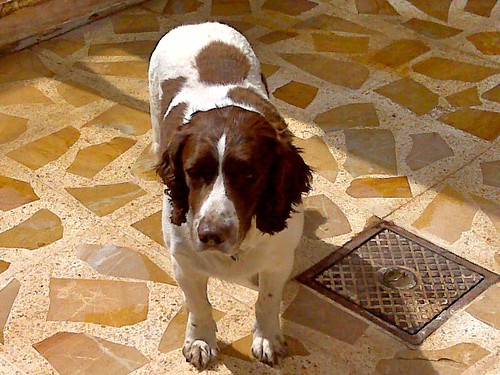
Sunday, June 13, 2010
Why Kurdish Journalists Can't Write
There are virtually no independent news organizations in northern Iraq. This may not surprise you. But what might is that freedom of the press is not Kurdistan's biggest media problem.
There is an audience for news here in a way we can't imagine in the U.S. Historically, the people of this region have been great readers. I was speaking with someone just today that told me that there's an old saying that goes: "The Egyptians write, the Lebanese print, and the Iraqis read."
This man remembered reading books as a child that simplified complex issues, like the theory of relativity. And everyone in his family read voraciously. But as he grew older, things began to change. Foreign books were banned or hard to come by. Papers were forced to publish positive articles about the regime. These lack of freedoms are the things we as Americans often imagine as Iraq's state of affairs under Saddam Hussein.
Then the U.S. invaded and handed power to Iraqi Kurdistan to become an autonomous region. (Kurdistan is part of Iraq but is run by a separate government than the rest of Iraq. Okay, poli sci lesson over).
It's at this point where, ironically, a whole new slew of problems started for the media in Kurdistan.
Anyone remember back to America's own journalism history? How cheap printing and distribution allowed for hundreds of opinionated people to start their own presses and share their views with the rest of the country? And then a few politically motivated heavy hitters began backing the newspapers they liked or made their own to make the news what they wanted people to hear?
That's what's happening in Kurdistan right now.
As soon as the limits to what could be printed here were lifted, everyone had something to say. Then, just like in the States, these papers started to solidify or dissolve according to how much money they had behind them. And in this region, that money comes from political parties. Right now, I'm told that there are dozens of newspapers printed daily, and that there are at least four major newspapers that are openly backed by political parties. (This applies to broadcast media too, but I'll stick to discussing newspapers here.)
This isn't necessarily a bad thing. The affiliations for each paper are clear - people know what slant they'll get depending on which paper they pick up. And these political parties can also protect journalists from criticism - or worse - if they publish articles on societal problems or expose corruption within the government.
The real problem with many of the papers here, people tell me, is that there are some real ethics issues within the papers themselves. There are a lot of published criticisms and accusations that are unsourced, poorly researched, and written to pick a fight rather than to promote public discussion. This, no doubt, has to do somewhat with the papers' political affiliations, but many attribute it to simply bad journalism. There's a thirst here for meaningful political and societal criticism. Of reporting that goes past finger pointing and parses crucial issues in a way that will help the majority find a solution.
In my conversations with people here, I haven't quite drilled down to why this is so hard for journalists here. One would imagine they would want to avoid tabloid-style accusations and commentary lest they end up like a recent Erbil journalist who was assassinated after he published a satire piece about President Barzani's daughter. While the journalist's death was publicly condemned, many have said that the journalist wasn't operating ethically to begin with - publishing highly critical but poorly sourced articles for months under a nom de plume, concluding with an immensely insulting (in this culture) article that in American terms translated to "Your Mama" to Barzani. He, along with everyone else around here, knew insults like that weren't to be taken lightly.
But people have another major problem with Kurdistan journalists, and it's the first thing they'll tell you about. Kurdish journalists don't know how to write. I can't read Kurdish but I'm told that many articles are so badly written that they don't make any grammatical sense. An editor recently told me that he hires twice as many copyeditors as journalists at his paper to catch all the errors his writers make.
But it's not their fault.
Why? Remember that Kurds have been suppressed in this region for decades, and in some neighboring countries, the use of Kurdish is still illegal. Many adults in this region grew up speaking Kurdish but learning academically in Arabic. When Kurdistan became an autonomous region, they happily turned from the Arabic of their "suppressors" and busted out with Kurdish signs, Kurdish taught in schools, and Kurdish literature, songs and poetry that is celebrated. Kurdish is celebrated, but until now, not widely written by Kurdish people.
To make things even more complicated, Kurdish itself is a sticky business. Kurds have been geographically separated in recent years into four separate nations, and the language has grown apart into dialects that are almost totally different languages in themselves. In some places, Kurdish is written in Arabic-style lettering. In others, Latin letters are used. Even in parts of Iraq, Kurds can't understand one another. This is common for many languages with regional differences - such as German, where Swiss German, Austrian German and Bavarian German are radically different from one another. The Germans solved this by instituting a universal "High German", which pretty much all German speakers can understand.
Unfortunately, there is no "High Kurdish". Though all schools in Kurdistan now teach in Kurdish, textbooks must be printed in separate dialects according to region. And poets and literati who insist on writing in "pure" Kurdish, which uses latin letters that represent the roots of Kurdish from the Ottoman empire (before Arabs introduced Arabic lettering), are not understood by the vast majority of Arabic-schooled Kurdish speakers.
So, Kurdish writers are left to wing it, to make up the grammar and spelling and proper usage as they go along. I can only imagine this could make for some really compelling literature -after all, it was the flexibility of the English language that gave Shakespeare such leeway for brilliance in his day- but when daily news depends on clarity and brevity, overcoming a basic problem like an unstandardized language is no small feat.
As a news editor, one of my main jobs is to make sure that writers comply with standards - standard dictionary definitions, standard grammar, standard AP style. I double check sources, question iffy statements and make sure that everything that comes from the publications I edit are watertight so that people can get a straight story they can trust. As I learn more about the challenges of writing here, I can only admire the tenacity of the journalists and editors who are trying to apply Western standards of journalism in northern Iraq. Keeping the "six honest men" on the straight and narrow is hard enough without inventing a language as you go.
Saturday, June 12, 2010
Neighborhood Fun Park

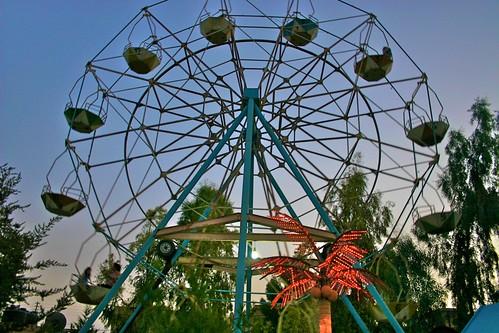
Friday, June 11, 2010
WTF Iraq: Grassy Patches
This is a yard, culled from stolen land from the empty lot next door or across the street, tended lovingly by young kids who long to play trucks and soccer on the 7-foot-by-foot square of lawn, and often appropriated by dads who just need a little time to themselves at dusk.
Ladies and gentlemen, I present the Grassy Patch.
Thursday, June 10, 2010
The ugly side of northern Iraq - Kurdistan Visa office
Let me say first, for being in Iraq, they really have their stuff together here. But the visa office is one place that still looks and functions like a war zone. A dirty amalgamation of tin shacks, shipping containers and horribly crowded and disorganized offices inside three floors of an un-airconditioned building... welcome to Iraq. Most of the officials speak very little English and each office, while technically numbered, may not actually be numbered, or numbered in arabic, or not numbered in order, or instead labeled something nonsensical like "Come in. Out Go."
Since I wasn't allowed to take any pictures, I went old school and drew a series of diagrams for what the typical process is for getting a one-month or three month visa. So far, after three days, we've only managed one month.
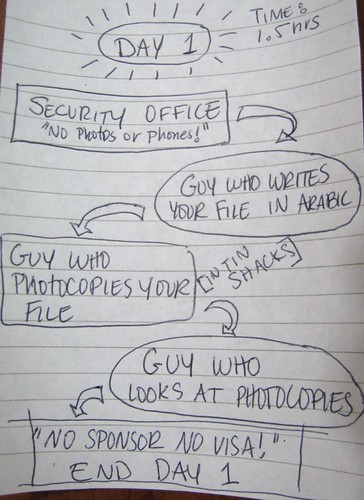
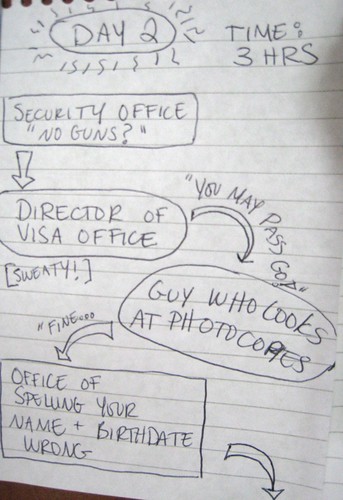

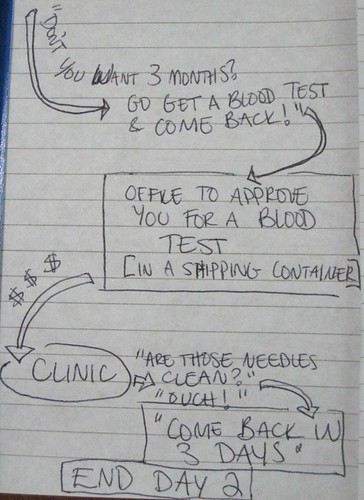

Monday, June 7, 2010
Grant arrives, we explore the citadel
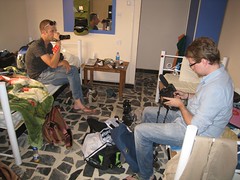
Then we headed up the hill for our first look at the citadel, an 8,000-year-old structure that is the longest inhabited citadel in the world. In recent years, the citadel was overrun by squatters, many of whom were kurds hiding from Saddam Hussein. So when UNESCO declared the citadel a world heritage site, they moved out the squatters to avoid further damaging the building structures.
We're working on a great story about the citadel, but for right now, I wanted to give you a feel for Erbil and what things look like from up there with a few pictures. Don't judge on the quality, just a few snaps with my point-and-shoot as we poked around:
Tomorrow we move into our new digs. It'll be the first time I'll be settled for more than a few weeks in something besides a hostel. Yay!
Sunday, June 6, 2010
WTF Iraq: The first installment
Let's start with these two:
It's so hot Erbil that the bazaar vendors face significant sun damage to their products. That, it seems, doesn't deter them from trying to sell their products anyway. I saw a stack of misshaped Kinder eggs for sale around the corner, ice cream with a whole first layer of ice-cream flavored puddle and now this, a power cord Jon bought in the bazaar for $6USD in the box. When he pulled it out at home, it looked like this:
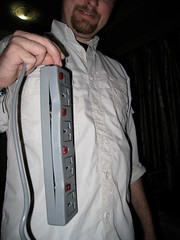
Needless to say, they're not so good about returns here.
But here's the real freaky weird WTF of the day. Last night, while on a late night Felafel run, we found this sitting in the middle of the sidewalk:
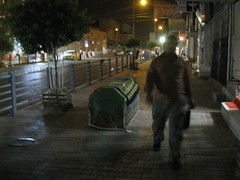
That's right, boys and girls, a coffin. In the middle of the sidewalk, in front of a cell phone store. When we tried to ask the store owner who was inside the coffin, we couldn't get a real answer. After posting it on facebook, we learned that this coffin, as well as two others, are ancient graves from city leaders that were there long before the marketplace, street or sidewalk popped up. Everything else was built around it and shop owners look after the grave site as part of their daily business.
Saturday, June 5, 2010
Erbil pub crawl
Day one of looking was a lesson in frustration. Our new Kurdish friends, or shall I say, Jon’s new Kurdish friends, said they would help us find a place in Erbil. This consisted of popping over to offices that were mostly closed and returning for hours at a time to drink chai at an un-air conditioned office where our new friends sold security cameras. Drenched in sweat, apartmentless and with new phones that didn’t work properly at all, we returned to the hotel defeated.
Day two was slightly better. We got the Internet working and managed to make contact with a relocation service who, conveniently, had space in their own villa that we might rent. We headed over with high hopes.
The office was run by a Texan who called himself Cowboy and invited us in for our first beer in the country. It was, I thought, perhaps the only place in Kurdistan where having nudie calendars on the wall was socially acceptable. We checked out their digs and agreed to meet up later at the Deutscher Hof, obviously the only German restaurant in town.
Shortly after checking things out we got a potential offer from the local university to stay in their teacher housing. But by the time we were able to pass our contact info along to the right person, he had gone for the day. Unfortunately, that meant that we’d have to wait till Sunday (weekends here are on Friday and Saturday) for the head decision maker for these things to tell us whether it was a done deal. The only thing left to do was keep looking and wait, so we decided to use our newfound weekend night to make the official bar crawl across Erbil’s expat pubs, mostly found in the Christian district of Ankawa, where alcohol isn’t a problem.
Our first stop was T-Bar, where we had our first pseudo American noshes in days (my pizza was a long roll of French bread with Mozzarella and canned mushrooms on top). Apart from the security scanner and a locker where you can check your weapons at the door, T-Bar reminded me of a bar I went to in Fort Wayne Indiana. when I was working on a grad school project. Brand new but already a little seedy, where everyone knew each other but Jon and me. Like many places around Erbil, T-Bar was packed but felt weirdly suburban.
Next, it was on to the Deutscher Hof, where apparently they were having a barbeque and Salsa dancing party. Here we met Cowboy and his friends, who were, it turned out, responsible for the nudie calendar I’d seen earlier. Apparently they operate a logistics group that often has to grease the hands of touchy officials. In a Muslim country, those yearly issues of scantily clad women were worth more than gold for their business. The guy told me that he kept stacks of them in his trunk just in case and that all the border controls knew him and wanted to be friends with him to get their own copies of the calendar. The first year they made the calendars, 500 copies ran out almost instantly. And as a result, he’s gotten himself out of lots of potentially rough situations.
While of course I generally condemn the objectification of women, I had to admit that his little business scheme was brilliant.
The salsa dancing classes were a somewhat pitiful sight. Of the 50 or so people at the bar, only four were women. I was determined not to dance. The bar owner, Gunter, a sage businessman dressed in a Hawaiian shirt, obviously knew what a little fresh meat could do to liven up his party and repeatedly returned to ask me to join the rest of the group onstage. I politely declined.
There’s a saying about Alaska, where there was once (and may still be) 40 men to every one woman: “The odds are good but the goods are odd.” I think it’s safe to apply the idiom to Iraq. I don’t know why, but in my head I keep comparing Erbil to a really hot dry version of Ketchikan, Alaska, where Dolly Arthur, with as much of an eye for money as the gold miners and and loggers became Alaska’s most famous (and I’m sure quite wealthy) whore, cause the pickings for women were so slim.
We ended our night at the Speedway, Erbil’s go-kart track and bar where, it seems, many expats tend show up at as the night is winding down. Group by group, all the people we had seen through the night started filing in, ordering up hard liquor and settling in with a hookah or two at each table. We didn’t last long there before deciding to call it a night. No biggie, we’ll be doing the same circuit again for the rest of the summer.
Thursday, June 3, 2010
Hello Iraq!
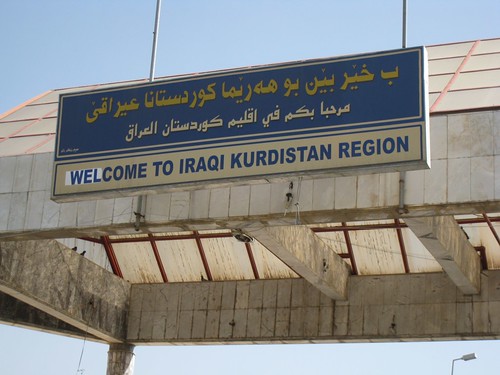
Two small tornados, six passport checks and a 10-hour drive later, I am officially inside Iraq. The day before yesterday’s border crossing was long, to say the least, piled in a car with three Kurdish men, who over the course of many hours asked Jon over and over again how he was doing and telling him that they were best friends, brothers, now. I was for the most part ignored, which was for the most part just fine with me.
 After a three and a half hour drive to the border, we easily passed border control and the military guards even kindly let me take pictures in front of the “welcome to Kurdistan” sign. They thought it was pretty funny as I stood there with a thumbs up in front of the Iraqi border. In fact, they all took turns taking pictures in front of the sign with me on their camera phones, all six of them. I am very popular in Kurdistan.
After a three and a half hour drive to the border, we easily passed border control and the military guards even kindly let me take pictures in front of the “welcome to Kurdistan” sign. They thought it was pretty funny as I stood there with a thumbs up in front of the Iraqi border. In fact, they all took turns taking pictures in front of the sign with me on their camera phones, all six of them. I am very popular in Kurdistan.It was supposed to be an easy couple of hours to Erbil, but we ended up making a stop along the way to one of the Kurdish men’s friend’s houses, who had gotten hit by a car about a month before. Within minutes of crossing the border I had my first experience with Iraqi Kurd hospitality. Inside the house, the entire family sat on cushions on the floor while the mother of the house (with a neck brace on) served all of us endless cups of chai and pistachios.
 I was shocked to see the women in the family dressed to the nines, covered with spangled silks, sparkles and lots and lots of gold jewelry. One of the girls had just gotten married, and over the wedding albums they explained to me that it is traditional for the man’s family to buy the bride loads of gold jewelry at the time of the wedding. In addition to looking fabulous, the gold serves as a sort of investment dowry, pieces that the new couple can sell off over time when they need money for a house or a car. For now the young bride in this house was dripping with her new bounty, from her hair to her toes. Of course as we left they wanted to take pictures with us too… I felt very plain standing next to these gorgeous women and now each time a woman draped in black walks by, I wonder what is underneath.
I was shocked to see the women in the family dressed to the nines, covered with spangled silks, sparkles and lots and lots of gold jewelry. One of the girls had just gotten married, and over the wedding albums they explained to me that it is traditional for the man’s family to buy the bride loads of gold jewelry at the time of the wedding. In addition to looking fabulous, the gold serves as a sort of investment dowry, pieces that the new couple can sell off over time when they need money for a house or a car. For now the young bride in this house was dripping with her new bounty, from her hair to her toes. Of course as we left they wanted to take pictures with us too… I felt very plain standing next to these gorgeous women and now each time a woman draped in black walks by, I wonder what is underneath.When we finally arrived in Erbil after dark, we went straight to an outdoor tea garden where we ate and met up with our new Kurdish friend’s friends. It was a beautiful and elaborate place that served mostly Turkish food.
I’d like to say that our night ended happily there, but unfortunately we still had to check into our hotel. As it turns out, the hotel Jon usually goes to was fully booked… as were the next three we tried. We finally found a room in the grossest, dingiest most disgusting motel I’ve ever stayed in. No, really. The lights wouldn’t turn on and the bathroom had a Turkish toilet that stank up the place like a port-a-potty. Luckily, I was so exhausted that even the smell couldn’t stop me from passing out. I hoped this wasn’t an appropriate introduction to what will be the next few months in Iraq.
Monday, May 31, 2010
Diyarbakir, local style.
[A Kurdish waterpark - note the mosque and ramshackle stone huts on the hills behind the olympic size pool]
After a quiet morning of work and sleeping in late, Jon and I got a phone call. It was Mehmet, and he was sending a car for us to meet him in a garden outside of the city, now. As I scrambled to change from my pajamas and put in my contacts, Jon said offhandedly, “from here on out, we’re not in control of our own lives.” He wasn’t joking.
The taxi Mehmet sent took us some 15 minutes outside of the city, to what turned out to be a waterpark and series of covered gardens frequented mostly by Diyarbakir locals. We were met by Mehmet, a delegation of Kurdish men, and another Mehmet (who in personality, size and importance I can only call Big Mehmet). Big Mehmet owned the waterpark and the hotel we had visited yesterday. He summarily introduced himself, told us he loved America, and took us for a tour of the grounds, which included an orchard, a small zoo and a giant swimming pool with waterslides. Then, we took a spot on a covered bench where a manmade waterfall trickled water over our feet to cool us down and Big Mehmet ordered food to be brought over.
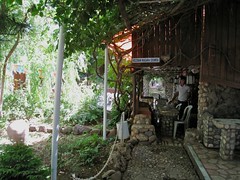 The chai started rolling, albeit a lot faster than our conversation. My Turkish being nonexistent, it was difficult for me to take part, and I’ll be honest, I’m still getting used to men not meeting my eyes for much of the time. So far, nothing’s stopped me from going where the men go and everyone has been exceedingly friendly, but little things, like when I ask a question and men address Jon instead, or men declining from shaking my hand (an Islamic taboo) are unsettling. Suffice it to say, with the language barrier and my uncertain position in these groups of men, I’ve been getting used to awkward silences.
The chai started rolling, albeit a lot faster than our conversation. My Turkish being nonexistent, it was difficult for me to take part, and I’ll be honest, I’m still getting used to men not meeting my eyes for much of the time. So far, nothing’s stopped me from going where the men go and everyone has been exceedingly friendly, but little things, like when I ask a question and men address Jon instead, or men declining from shaking my hand (an Islamic taboo) are unsettling. Suffice it to say, with the language barrier and my uncertain position in these groups of men, I’ve been getting used to awkward silences.
After a few hours in the shade of Big Mehmet’s gardens, we returned to town to meet up with Jon’s friends in town. With the family’s two teenage boys, we wandered to some of Diyarbakir’s more famous sites, including the Ulu Camii mosque and a church hidden in the winding streets of the neighborhoods that was built in 300 AD.
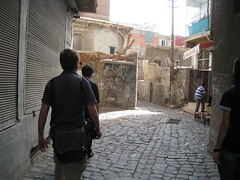
On the way back from the church we stopped in a candy shop where they were making hard sugar candies from scratch. We watched as they took a 25 kilo blob of melted sugar and sesame seeds and stretched it into sweet seedy goodness in front of our eyes. They passed us some candy – still warm – to munch on as we left.
Then, on to the family home where I was about to eat the largest meal of my life. Jon’s honorary Turkish mom had cooked up a feast, with dolmades, stuffed peppers, a tomato and meat stew to be eaten with homemade bread, salad and cherries in cold juice. Then baklava, cherries, apricots, watermelon, candy and more chai! Always more chai. I might turn into one of those tiny glasses of chai soon. Jon’s Turkish mom was incredible – each time we finished something she would pile more food onto our plates before we had a chance to say no and agitate until we cleared it. I felt her disappointment and my own as after two helpings of stew, three stuffed peppers, two stuffed eggplants, and two handfuls of bread, I had to push my plate away in defeat.
As we left, she gave me a scarf covered in sequins and told me that she had never had a daughter, so every time I was in Diyarbakir I could come to her house and I would be hers for however long I stayed. We left with a promise to return on our way back from Iraq, in some two and a half months.
Tomorrow we will officially cross into Iraq. I’m no longer nervous, just very very curious to see what this new city and culture will hold.
A day in Diyarbakir

As the plane touched down in Diyarbakir on Sunday, I was a little nervous. I was officially entering the most conservative area I’ve ever been in, and my normal obsession with properly observing social mores was thrown into overdrive in a culture that I knew nothing about. I was almost the only woman on the plane without a headscarf.
Once we made it into the city, however, my worries began to ease. Diyarbakir is one of the largest cities in Turkey and although Southeast Turkey is more conservative than the rest of the country, I saw plenty of women dressed just like me.
My worries eased, I began to concentrate on taking in this new city. Jon and I checked into Hotel Birkent, a clean but fairly bare bones operation with a toilet that requires one foot to be in the shower in order to sit on it properly. Once we settled in and got ourselves a hearty Kurdish breakfast (the saltiest cheese I’ve ever tasted, intense yogurt, cucumbers, tomatoes, an egg, bread and of course, chai) Jon and I hit the city so he could show me a few highlights.
First, the bazaar, where I picked up a headscarf to explore the mosques. The shopkeepers took every opportunity to lament to us that U.S. had beat Turkey the night before in the world cup.
Then, knowing me so well, Jon took me to the cheese market – the Kurds, it turns out, are as besotted with cheese as I am, and there’s a whole market dedicated to these aged delights. One of their most popular cheeses, a tangy crumbly kind that’s often found with platters of mezze, is buried under the ground for a year to age properly. I was enthralled with the giant blobs of cheese just sitting on the table waiting to be gobbled up – the cheese sellers couldn’t miss my absolute delight, and kept giving us pieces to try. Along with the cheese (it just kept getting better) were olives and honey, straight off farms outside the city.
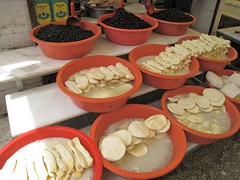
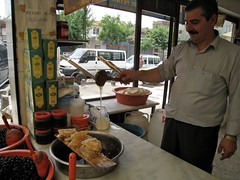
Then, on to the Otel Büyük Kervansaray, a resting spot built for pilgrims traveling along the silk road in the 1500s that is still being used as a hotel today. While we wandered the grounds, a man who worked there noticed us and began to talk with us. His English was surprisingly good, because he has worked with the U.S. army for a while and has since operated a souvenir shop and tours of the Kurdish areas of northern Iraq and southeast Turkey. He invited us into his shop for tea and later we agreed to meet for more chai after dinner.
Our final stop was a climb of Diyarbakir’s city walls, which are the second largest in the world, after the great wall of china and date back to the Byzantine era. From our vantage point at the top of the walls, we could see a river and ancient bridge that cut through endless fields of farmland.
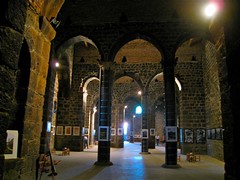 [Inside the walls, we found an art show and teahouse]
[Inside the walls, we found an art show and teahouse]Diyarbakir has subtle delights for tourists. It isn’t old in the way that I know old – not the old of western Europe, the kind of old that has been lovingly restored then put to some twee use. This city has been lived in – roughly, robustly, continually – since before Christ was born and people just don’t think twice about it. Men still gather just outside the mosque, one of the oldest in turkey, to tell stories with each other. Through a cobbled alley, a townhouse built and rebuilt over hundreds of years serves up chai and Kurdish dishes on large cushions in a big courtyard. And in the bazaar, cobblers and blacksmiths work alongside spice shops filled with huge burlap bags of herbs I couldn’t name.
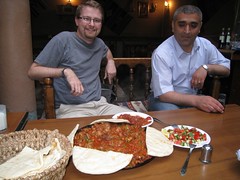
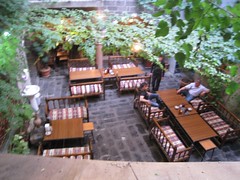
[Jon and an old friend, the proprietor of this hidden wonder of a restaurant, with my first taste of Sac Tava – my taste buds rejoiced!]
Outside the city walls, the city is more modern, with street after street of soviet style six-story pastel apartment buildings. Down the main street outside of town is a long row of chaihanas, or tea shops, where men meet and play backgammon. We ended the night there with our new friend Mehmet and Jon’s old friends from the city, drinking endless cups of chai and smoking apple flavored hookah.
Sunday, May 30, 2010
Istanbul: The first encounter
 As I said before, I arrived in Istanbul five days ago. As we drove into the city for the first time just before midnight, the dozens of minarets from mosques on the hills around the Bosporus were thrown into high relief against the night sky. I couldn’t help pressing my nose against the taxi window like a child.
As I said before, I arrived in Istanbul five days ago. As we drove into the city for the first time just before midnight, the dozens of minarets from mosques on the hills around the Bosporus were thrown into high relief against the night sky. I couldn’t help pressing my nose against the taxi window like a child.
Our hostel turned out to be a clean and nondescript townhouse just off of Taksim Square. Taksim, and the long street that runs from it, Istiklal Caddesi, make up the heart of “new” Istanbul – where thousands of people pile into the streets at all times of day and night to shop, eat and drink until their livers scream.
Sensory overload is inevitable when walking down this street. The hordes of people, motorbikes, trolleys and taxis that are all in a hurry to go somewhere; the smells of roasting chestnuts, kebab and spices I couldn’t identify… and oh, the sounds! Honking horns, violins, traditional Turkish songs and pop music, the speakers from the tops of minarets calling Muslims around the city to prayer, all mixed together at once. It was like nothing I’d ever experienced.
I’d like to think I’m a seasoned enough traveler to not grin like a child or stare openly, but it seems I’ve been doing a lot of that here. The diversity of things to look at makes me gawk, and for the first time in a very long time, I can’t understand a thing that’s going on language-wise, which makes things more confusing and a lot of fun. Luckily, Jon speaks enough Turkish to help us both get by, so I'm content for once to stick out like a sore thumb and just let this new world soak in.
In the four days that we spent in Istanbul, I saw none of the important sights that everyone sees. We’ll have time enough on our return trip on the way home. This time around, we slept late and just wandered, through the late afternoon and into the night, through the streets that curl around this side of the city.
[Jon looking like a badass while smoking a hookah at the beanbag bar under the bridge that he once described to me was his "favorite place in the whole world."]
If our time here had a theme, it was perhaps seeing cityscapes from all directions. Rooftops have more importance here than anywhere else I’ve been, and any apartment building or business could be hiding an amazing terrace just five or six floors above.
Jon took me to 5.kat, a beautiful rooftop restaurant and bar with a leafy terrace that offered some of the best views I’ve seen, perhaps ever. As we ate, the bridge across the Bosporus, strung with lights, changed color every few minutes. The next day we decided to make a night of poking through Taksim’s incredible array of pubs and bars. Each building has five or six bars or restaurants that take up individual floors, and if you make it to the roof of any of these (no mean feat once you’ve got a bit of a buzz on those small windy stairs!) you’ll be treated to a living diorama of the city. Rooftops nearby and restaurants with retractable roofs are lit like dollhouses so that you can look out across the sky and see people dancing, drinking, kissing and smoking. From each of our perches we watched the other rooftops to pick our next haunt. And so we hopped from roof to roof, finally ending up, flip flops and all, at arguably the most popular of Istanbul’s clubs, 360.
There were other things we discovered too – back alleys stuffed with antique shops, “French Street”, a narrow and steep passage of Parisian cafes with cobblestones and lights imported from Paris… All the tiny things - you know how I love tiny things - like tiny chairs that men sit on and drink tiny cups of Chai from. Oh, and perhaps only a discovery for me – ice cream so thick it was actually chewy!
[Pictures of a Chaihana with teeny tiny chairs and grown men sitting on them! Note my delight.]
When we packed up our things at 4am this morning, I didn’t want to go. But since I know I’ll be back in just a couple of short months, it made it easier to speed over the Bosporus once more, as Istanbul’s skyline twinkled across the water.
Night in Istanbul
Before I start, I will acknowledge the fact that the first half of this long journey I’ve been on during the past few months went wholly undocumented on this blog. South Africa was a whirlwind that I’m still processing, and our intense work hours left me little time to stop and think about what I saw and learned. Hopefully as I settle into a routine I’ll be able to take some time to put to words some thoughts and feelings I have about that sweeping, beautiful country.
For just a taste of what I saw, I'll cheat a little and add this slideshow made by Jon and posted on his own blog:
South Africa - Images by Jon Vidar
But for now, I will write from the beginning of this new trip, which starts in Istanbul.
Tuesday, March 2, 2010
A little context before we begin.
First to South Africa, where I will write a new kind of travel guide for intrepid explorers and produce multimedia stories about a nation in flux in advance of the World Cup.
Then to northern Iraq, where I will be teaching I will work with the nonprofit I help to run, The Tiziano Project, to teach aspiring and professional journalists new media and multimedia journalism skills.
I've been working for over a year to help The Tiziano Project prepare for these upcoming training sessions. We provide community members in conflict, post-conflict and under-reported regions with the equipment, training and affiliations necessary to report their stories and improve their lives. Our organization has found its success through collaboration -- something that, over and over, our Impact bloggers have stressed is necessary to overcome the financial and bureaucratic confines of nonprofit business. We work with news agencies to promote stories that wouldn't otherwise be heard, to train people who wouldn't otherwise have a global voice, and to create sustainable community work where otherwise there would be none.
For the duration of our Tiziano: Near East program, we will be working with community members from the Iraqi Kurdish minority to produce multimedia stories about their singular experience of facing of centuries-long discrimination and their recent turn to near-autonomy within northern Iraq. I, and my fellow trainers, will be working with our students to produce additional reporting to give those less familiar with this culture context and depth.
Here, you will find updates from my journey and the reports I produce. But this is also a story about me -- a vastly curious young woman with a penchant for examining the world with wide eyes and straight talk.

